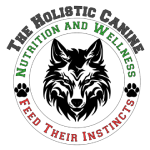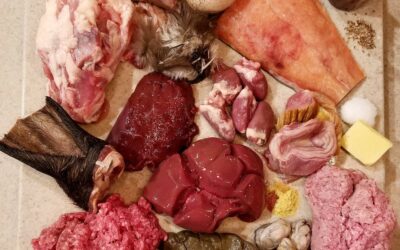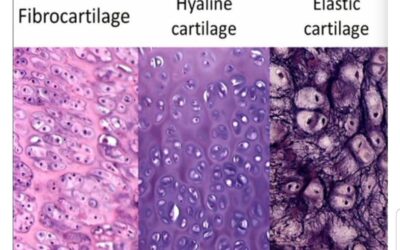A Critical Look at Cellular Inflammation & How to Protect Our Canines
Life is in the cells, thus, health is in the cells. Nothing can exist without cellular function. As a practitioner, my focus is zeroed in on what is happening at the cellular level. A common and growing concern in our modern age is chronic cellular inflammation in both humans and animals. When we think of inflammation, most people will bring to mind swelling, heat, pain, redness, and loss of function such as what is experienced with an injury. Cellular inflammation, however, is something entirely different; for one, it is not discernable. Truth be told, it is the leading cause of chronic disease. When inflammation of the cell membrane occurs, it disrupts cellular communication, adversely modifies cellular detoxification, and affects gene expression which often leads to a genetically predisposed disease. More specifically, cellular inflammation is characterized by increased activity within a cell as a result of an adverse outside influence which directly causes a disrupt in hormonal signaling throughout the body network.
We live in a world that is inundated with chemicals and pollutants that are directly contrary to the needs and functioning of cells. Cells receive the majority of their needs from food, water, and air. The major concern when feeding our dogs (and our own bodies) is the less-than-adequate, highly processed, genetically modified foods grown in mineral-deplete soils with a generous measure of pesticides, insecticides, and fungicides. The bodily cells of too many dogs are relying heavily upon these foods for their nutrient needs. And unless you offer water that is filtered by reverse osmosis (and possibly the addition of UV light) you can add a copious array of heavy metals and additional chemicals and contaminants to the list of cellular antagonists. And why not throw in the air pollutants? In defense, cells must do their best to protect and repair themselves for the purpose of maintaining life. When the barrage of antagonistic environmental and food factors is consistent, we are left with a chronic condition that generally spells a life of chronic disease, pain, suffering, and premature death. Our pets are left most vulnerable. Their life expectancy is far lesser than ours and thus have a greater need for being protected from environmental onslaught and inadequately supplied nutritional requirements.
If we examine chronic cellular inflammation more closely, it is not difficult to recognize that this is a very real concern. Every cell contains what is known as Nuclear Factor-kappaB (NF-κB), a gene transcription factor. When an increased activity in NF-κB occurs, the inflammatory response is activated. The NF-κB is activated by reactive oxygen species1 (ROS), microbial invasion (acute illnesses or infection), and the cells own generation of eicosanoids (signaling molecules) and their interaction with inflammatory cytokines (vital for cellular signaling; the primary cytokine that activates NF-κB is TNF- tumor necrosis factor). It has been shown that NF-κB activation is heavily influenced by diet. Thankfully, NF-κB can be controlled through a nutrition strategy that greatly reduces inflammation rather than promoting it.
One such study found that essential fatty acids have the greatest influence on NF-κB activation. Of particular note is the omega-6 fatty acid arachidonic acid (AA). The study found that AA activates NF-κB, while the omega-3 fatty acid eicosapentaenoic acid (EPA) does not2. More recent studies have determined that the single most influential factor in cellular inflammation is insulin. Insulin is produced and secreted by the pancreas in the presence of glucose. Glucose is the digested or broken-down form of carbohydrates. While the inflammatory response is the same in humans as well as dogs, dogs have absolutely no requirement for carbohydrates making them far more vulnerable to the effects of carbohydrate consumption, especially in the form of processed commercial foods and homemade diets that contain starches, grains, and beans (species inappropriate foods). Dr. Francis M. Pottenger’s cat study3 speaks volumes to the effects of offering species inappropriate (cooked and adulterated) inflammatory foods to animals and thereby the conditions and diseases these produce and transfer to each consecutive generation. Dogs consuming high carbohydrate diets are at the highest risk for further inflammation that occurs not only in the cell membrane, but also in the inner mitochondrial membrane. The mitochondria are the power generators of the cells. When mitochondria become inflamed, metabolic processes, defense mechanisms, health, vitality, and energy levels plummet.
For our canines, it is not enough to simply supply required nutritional needs such as through commercially prepared processed diets, homemade meals, or tap water without any regard for the probable inflammatory-producing activity the food and water may generate. This is a key explanation for why we see chronic disease and cancers in both commercially and homemade fed dogs. While processed commercial foods have shown to be a direct and leading cause for chronic cellular inflammation, homemade foods that contain inflammatory foods are in no way a better option. The vehicles (foods) by which we deliver nutrients to the body is of fundamental importance. A so-called “complete and balanced” diet is in no way complete or balanced if NF-κB activation occurs and leads to a chronic inflammatory condition thereby greatly increasing the likelihood of a diseased state. We must look at the whole picture. Food is meant to nourish the body in ways that go far beyond simply protein, fats, carbohydrates, vitamins, and minerals. Foods contain a plethora of components and constituents that affect the body either positively to produce health or negatively which promotes disease. True nutrition science looks at the affects and effects that foods have on biological systems.
Gut inflammation from species inappropriate foods is often the start of a chronic cellular inflammatory condition. Offering foods that are not appropriate to a canine’s digestion and physiology are the cause for inflammatory activation within the intestinal cells. The result is irritation of the gut lining. A series of physiological actions follow hence decreasing cellular network communication most notably with the brain. The effects of an irritated and inflamed gut decreases nutrient uptake and absorption. The whole goal of nutrition is to deliver adequate nourishment to the cells. Foods are meant to provide the vital nutritional energy and components that are required to maintain life, cultivate optimal health, and amplify the ability of the cells to efficiently defend and heal. If cells become inflamed, cellular nourishment is not achieved. Preventing malnourishment begins by offering biologically-appropriate unadulterated wholesome foods that prevent inflammation. This begins with knowing which foods are implicated in inflammatory responses in canines. Inflammation producing foods are:
- Rendered fat, rancid fat, & cooked fat (pancreatic inflammation)
- Grains, legumes, & processed carbohydrates
- Processed, adulterated proteins & meat by-products
- Preservatives & food coloring
- Starches, insoluble fibers, & fillers
- Canola oil, soybean oil, corn oil, cottonseed oil, sunflower oil, rapeseed oil (dogs are carnivores and require animal fats)
- Foods that cause sensitivity symptoms as per the individual dog (any and all, especially allergic responses)
- Fish oils
- Proteins from animals fed grains (especially genetically modified grains such as corn and soy)
- Toxin-heavy foods such as farmed fish and conventionally raised/grown foods
- Commercially-raised grain-fed chicken and pork (high in omega-6 fatty acids)
- Commercial eggs from grain-fed caged birds
- Tap water (and conversely, offering distilled water. This will mineral-deplete your dog FAST!)
- Heavy supplement use, especially synthetic isolates and inorganic minerals
- Unbalanced diets & unbalanced fats
Avoiding or healing cellular inflammation begins by greatly reducing or eliminating the above listed foods. What follows is the restoration of the cellular membranes via an anti-inflammatory diet strategy. A species-appropriate balanced raw diet is by far the best strategy for a carnivore IF, and only if, the diet includes easily digestible foods that, first and foremost, do not irritate the gut and thus adequately nourish cells and discourage an inflammatory response. Adding in phytochemical and antioxidant-rich organic vegetables and fruits can also be a part of an anti-inflammatory strategy. Be sure to first discover if your dog is able to digest the vegetation you choose. And be aware that many dogs cannot have fruit as the fruit sugars can be problematic in reactive dogs thus contributing to an overgrowth of yeast. This is a prime example of an inflammatory response to healthful, nourishing foods.
While chicken and pork are heavy in omega-6 fatty acids, they should not be avoided entirely as omega-6 fatty acids are essential to the cells. However, offering your dog free-range chicken and pork is a much better option and helps to nourish cells rather than encourage cellular reaction. Knowing how to balance fats is pivotal to the prevention of inflammation. As indicated in the study above, the omega-3 fatty acid EPA prevents NF-κB activation. Including foods and whole-food supplements into meals that are rich in EPAs is essential. Because of the condition of our food supply coupled with environmental toxin exposure, feeding omega-3 fatty acids in a ratio of 2:1 omega-6 to omega-3 is highly recommended. Wild-caught fatty fish (free of contaminants) are excellent sources of omega-3 fats as well as grass-fed beef and bison, pasture-raised chicken and duck eggs, marine phytoplankton, and krill oil. Raw diets that contain a variety of red meats, poultry, fish, and omega-3 supplements are the most appropriately balanced and provide the greatest protection against cellular inflammation.
On a final note, completely avoiding all grains, legumes, and starches is a vital step. Carbohydrates in the presence of fats has been shown to exacerbate the inflammatory response. In the presence of insulin, animal and vegetable fats can become inflammatory on top of the inflammatory producing grains, legumes, and starches. While these foods may be beneficial to humans when sprouted and pressure-cooked to remove toxic anti-predation lectins, anti-nutrients, and enzyme inhibitors, they are not suitable for canines. These are rich in gut-irritating insoluble fibers (even to humans) and non-essential carbohydrates that break down to useless sugars spiking insulin and resulting in inflammation, weight gain, and an enlarged pancreas. Additionally, grain and legume proteins lack the correct amino acid ratios for carnivores besides the very obvious fact that carnivores do not and would not consume grains even in the absence of prey. Carnivores lack the digestive capacity to breakdown grains and legumes for nutritional purposes.
The purpose of nutrition is nourishment and to provide the body with an energy source. Feeding the body foods that encourage cellular reactivity and are problematic to digest requires the use vital energy making more work for the body. This serves to lower vital nerve energy and create a state of enervation. Energy and vitality are the highest representations of true health and wellness.
©2019 Kimberly Lloyd, PhD. BCHHP, Cert Raw Dog Food Nutritionist
1 Reactive Oxygen Species (ROS) are reactive molecules containing oxygen that are produced by excess free radical formation via environmental toxins, metabolism, blood cells, emotional stress, as well as being introduced via diet that directly damage cells.
2 Camandola S, Leonarduzzi G,Musso T, Varesio L, Carini R, Scavazza A, Chiarpotto E, Baeuerle PA, and Poli G. “Nuclear factor kB is activated by arachidonic acid but not by eicosapentaenoic acid.” Biochem Biophys Res Commun 229:643-647 (1996).
3 Francis Marion Pottenger Jr., Pottenger’s Cats: A Study in Nutrition, Price Pottenger Nutrition; 2nd edition, June 1, 2012.



